Japan’s railway system offers more than efficient transportation—it provides access to some of the world’s most breathtaking scenery. From snow-capped mountains to coastal waters, these train routes showcase Japan’s natural beauty in ways that highways simply cannot match.
The Magic of Japanese Train Travel
Japanese trains are renowned for their punctuality and comfort, but the real treasure lies in what you see through the windows. The country’s geography creates diverse landscapes that change dramatically as you travel from region to region. Mountain ranges give way to rice fields, urban centers transition to pristine coastlines, and seasonal changes paint the scenery in ever-shifting colors.
Top Railway Routes for Scenic Views
Tokaido Shinkansen: Mount Fuji Views

The Tokaido Shinkansen between Tokyo and Osaka offers one of Japan’s most iconic railway experiences. On clear days, passengers on the right side of the train can see Mount Fuji rising majestically above the surrounding landscape. The best viewing opportunities occur between Kozu and Atami stations, approximately 45 minutes after departing Tokyo.
The mountain appears for just a few minutes, making timing crucial. Weather conditions significantly impact visibility, with early morning and late afternoon typically offering the clearest views.
JR Tadami Line: Valley Scenery
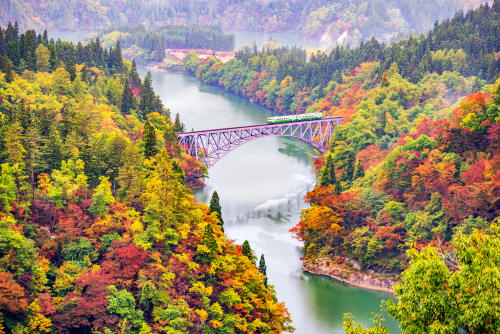
The Tadami Line in Fukushima Prefecture traverses remote mountain valleys and pristine forests. This local train line crosses numerous bridges, including the famous Tadami River Bridge, which offers panoramic views of the surrounding wilderness.
Autumn transforms this route into a corridor of brilliant reds and golds. The train moves slowly enough for passengers to appreciate the detailed landscape, from traditional farmhouses nestled in valleys to dense forests covering mountainsides.
Hakone Tozan Railway: Mountain Ascent
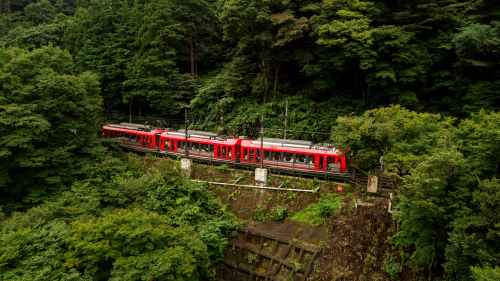
The Hakone Tozan Railway climbs through steep mountain terrain, offering dramatic elevation changes and spectacular views. This narrow-gauge railway features switchbacks that provide different perspectives of the same scenery as the train zigzags up the mountain.
During spring, the route passes through tunnels of cherry blossoms. Summer brings lush green forests, while autumn creates a tapestry of colorful foliage. Winter occasionally blankets the landscape in snow, creating a completely different but equally stunning experience.
JR Gono Line: Coastal Beauty
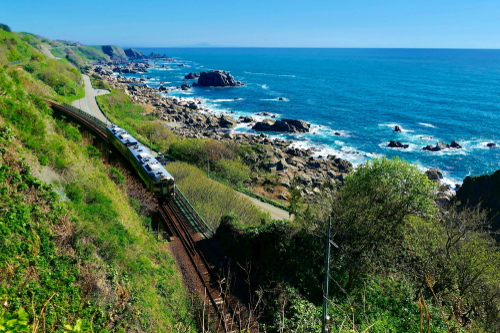
The Gono Line runs along Japan’s western coast, providing unobstructed ocean views. The train travels close to the shoreline, offering passengers direct views of the Sea of Japan’s waves crashing against rocky cliffs and sandy beaches.
Sunset journeys on this route are particularly memorable. The train’s schedule aligns with golden hour during certain seasons, creating perfect conditions for photography and quiet contemplation.
Seasonal Transformations
Spring Cherry Blossoms
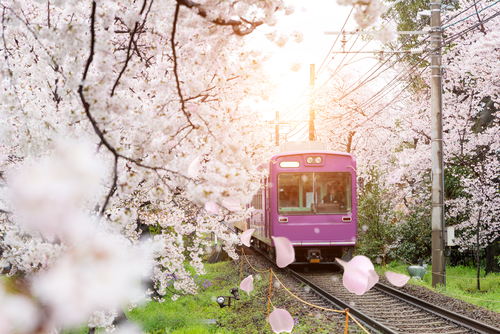
Spring brings sakura season, when cherry trees bloom across Japan. Several railway routes pass through areas famous for their cherry blossoms, including sections of the Tohoku Shinkansen and various local lines.
The blooming period is brief, typically lasting only one to two weeks in each location. Planning your journey requires careful timing, as peak bloom dates vary by region and elevation.
Summer Green Landscapes
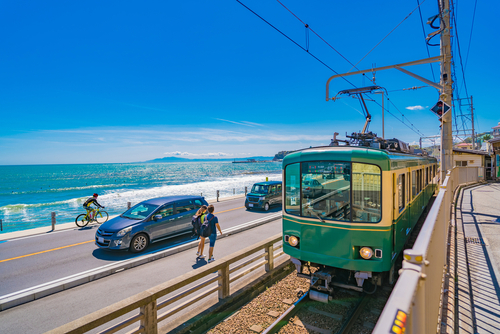
Summer transforms Japan’s countryside into vibrant green expanses. Rice fields reach their lushest state, creating mirror-like surfaces that reflect the sky. Mountain regions offer cool escapes from urban heat, with dense forests providing natural air conditioning.
The Joetsu Shinkansen through Niigata Prefecture showcases extensive rice paddies during summer months. These agricultural landscapes demonstrate Japan’s farming heritage while providing serene views from train windows.
Autumn Colors
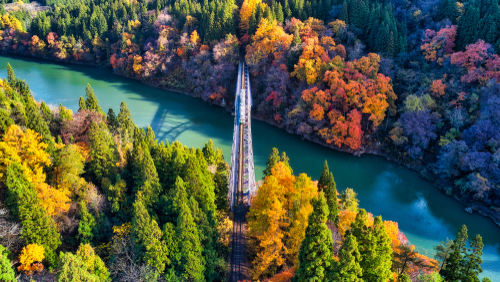
Autumn is widely considered the most spectacular season for railway travel in Japan. The changing leaves create natural artwork that shifts daily as temperatures drop and daylight decreases.
The timing of autumn colors follows elevation patterns, with higher mountains changing first and lower elevations following weeks later. This progression allows travelers to chase the changing colors by selecting different routes throughout the season.
Winter Snow Scenes
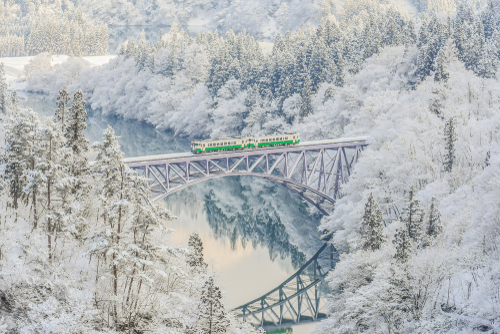
Winter brings snow to much of Japan, creating dramatic monochrome landscapes. The contrast between dark evergreen trees and white snow creates striking visual compositions that change constantly as weather patterns shift.
The Joetsu Shinkansen through the Japan Alps offers some of the most reliable snow scenery. Heavy snowfall in this region creates deep accumulations that persist throughout winter months.
Photography Tips for Train Travel
Equipment Considerations
Train photography requires specific techniques due to motion and reflections. Fast shutter speeds help freeze moving scenery, while polarizing filters can reduce window reflections. Cleaning cloths prove essential for maintaining clear glass surfaces.
Timing and Positioning
Researching route timing helps maximize photography opportunities. Sunrise and sunset provide optimal lighting conditions, while midday sun can create harsh shadows. Seat selection matters—research which side of the train offers the best views for your specific route.
Respectful Photography
Japanese trains maintain quiet, respectful atmospheres. Flash photography disturbs other passengers and creates unwanted reflections. Silent camera modes and discrete positioning ensure comfortable travel for everyone aboard.
Planning Your Railway Journey
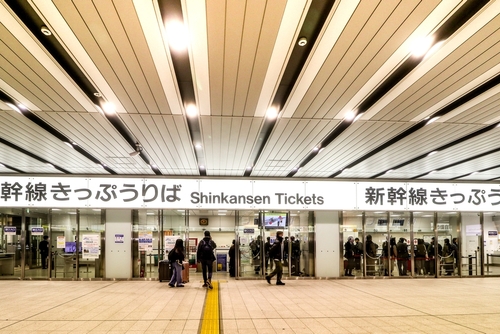
Route Research
Different routes offer distinct experiences throughout the year. Research seasonal highlights for your travel dates, as timing significantly impacts what you’ll see. Local weather patterns affect visibility, particularly for mountain views.
Ticket Reservations
Popular scenic routes fill quickly during peak seasons. Reserved seating guarantees window access and optimal positioning for viewing. Japan Rail Pass holders can make seat reservations at no additional cost for most routes.
Travel Preparation
Comfortable clothing and charged camera batteries enhance the experience. Snacks and beverages from station vendors add to the journey’s enjoyment while supporting local businesses.
Cultural Appreciation
Railway travel in Japan offers insights into daily life and cultural values. The quiet, orderly nature of train travel reflects broader cultural norms about public behavior and mutual respect.
Observing fellow passengers and station interactions provides cultural education beyond the scenic views. Local passengers often demonstrate proper etiquette and can serve as examples for international visitors.
Making the Most of Your Journey
Japanese railway travel offers unparalleled access to natural beauty combined with cultural immersion. Each route provides unique perspectives on Japan’s diverse geography and seasonal changes.
The key to memorable railway experiences lies in preparation, patience, and appreciation for both natural scenery and cultural context. Whether chasing cherry blossoms in spring or autumn colors in fall, Japan’s trains provide front-row seats to some of the world’s most beautiful landscapes.
Plan your route carefully, respect local customs, and prepare to be amazed by the incredible views that await outside your train window. Japan’s railways offer more than transportation—they provide journeys through some of the most beautiful scenery on Earth.
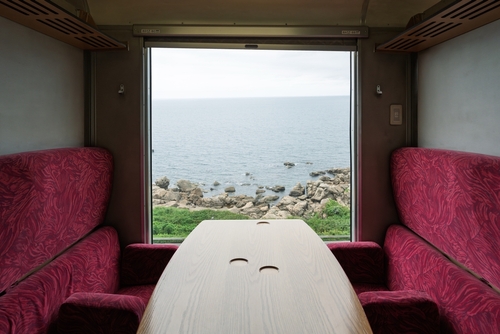
Frequently Asked Questions
Do I need to purchase train tickets in advance?
While some local trains allow you to purchase tickets on the day of travel, it’s highly recommended to book tickets for reserved seating on popular routes, especially during peak travel seasons like spring and autumn. The Japan Rail Pass can also be an excellent option for unlimited travel on eligible trains.
Are there luggage restrictions on Japanese trains?
Yes, there are limitations on luggage sizes, particularly for certain Shinkansen (bullet train) routes. Larger suitcases often require advance reservations to ensure enough space is available. Ensure your luggage complies with the specified size limits to avoid any issues.
Can I use cash to buy tickets or access stations?
Yes, cash is widely accepted at ticket counters and vending machines in most train stations across Japan. However, IC cards like Suica or Pasmo provide a convenient and quick contactless payment option.
Are English signs available at train stations?
Most major train stations in Japan have English signage and announcements, making it easier for international travelers to navigate. Smaller, rural stations may have limited English support, but staff are usually helpful.
Is it safe to travel alone by train in Japan?
Japan is known for its exceptional safety, and train travel is no exception. Whether traveling alone, with family, or in a group, you can feel confident in your personal safety while enjoying the rail experience.